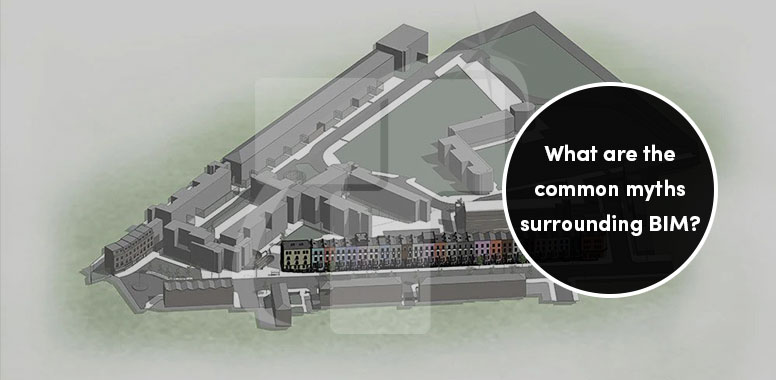What are the common myths surrounding BIM?

Building Information Modeling (BIM) is a particularly integral asset for the construction and development industry. Revit BIM Services helps in providing a 3D visual database to complete project construction effectively. It consists of the development information and major plans which is required at the time of actual construction so that we can fabricate the tasks accordingly. Proprietors are presently equipped for seeing into the future and can settle on choices with certainty.
Over the period, BIM’s acceptance and acclaim have developed at a consistent rate. It appears that the architects have quickly changed their impression of BIM from being a tool for designing a necessary tool in recent years. The outstanding benefits that we receive by using BIM in the process are recognized and acclaimed by the AEC industry. Today, many countries have made it compulsory to produce BIM for any building constructed. Sooner or later United Stated is going to give a command to necessitate BIM into their process.
In case you’re an architect, planner, designer, engineer, contractual worker, proprietor, or customer, you will certainly profit by BIM.
BIM is the foremost creative instrument used now a day, giving firms an edge over different organizations that have not implemented the use of BIM. Despite the fact that BIM is accepted and acknowledges very well by the AEC industry, there are still some negative thoughts about standardizing BIM. There are many misconceptions that the firms face before implementing BIM in their firms. Sooner or later, BIM is going to be mandated by all the governments across the globe, and it would be better for the firms to know the common myths surrounding BIM before integrating BIM into their process.
Myth 1: BIM is not useful for small firms or small projects
Small firm’s stakeholders are reluctant to implement BIM in their process as they believe that their hierarchical structure is quite straight forward and that BIM will just confound it. Small projects also face the same difficulties and have minute detailing to be done regardless of the size of the project.
BIM helps small firms to easily pitch their ideas to clients by showing them 3D visualizations and also show them one’s capabilities of using BIM for designing work. Successful implementation of BIM brings more productivity and accurate designs. BIM helps to coordinate designs efficiently with all the people involved in a single project.
Another analysis of BIM is that it is just for vast activities or large organizations, yet as the strategy has advanced, so has the usefulness. Present-day BIM is about availability, extendibility, and coordinated effort.
Myth 2: The process of BIM implementation is a costly affair
The expenses of implementing BIM into their process is an issue to worry about; however, there have been companies which has shown amazing returns on investment after they make the jump to BIM.
There are undoubtedly some costs associated while shifting from the traditional method of designing to using BIM; however, the benefits would be way more in the long run.
Most BIM software manufacturers don’t expect you to buy yearly memberships, but you can subscribe for the same with minimal monthly rental expenses.
Also, people think that implementation of BIM requires the designers to be trained, but the fact of the matter is that it is self-explanatory and they would be able to put the software to use easily without any extra training or cost.
Indeed, Individuals do need to get open to utilizing the product, and information should be ported across from other systems, so this can require significant investment in time and money. There will be a budgetary expense to utilize new software; however, this is expected over the long haul. The time cost reserve funds and different advantages these arrangements give far exceed the underlying agony and cost.
Myth 3: Only 3D Modeling can be done in BIM
Revit Modeling Services isn’t just about attracting things in 3D measurements. While 3D models are maybe the most visible, visual appearance of changed methods for working, they are just piece of a lot more extensive procedure. BIM isn’t just about making a visual portrayal of a physical article or substance; instead, it’s tied in with working cooperatively to create computerized datasets. This information (both graphical and non-graphical data) is stored in an advanced mutual space known as the Common Data Environment (CDE) where it tends to be utilized to create united models. In outline, the data stored in BIM never expires and stays for a lifetime. BIM also helps in Planning, Scheduling, Costing, Energy sustainability analysis, and Facility management of a project. It is more than just preparing 3D models using BIM.
Myth 4: BIM needs to be trained and special resources
It is human nature to be reluctant of any change or upgradation that comes up. BIM is easy to be implemented if you realize its future outcomes which are going to be beneficial for you. The designers don’t need any specialized training to be able to implement BIM, but only a little basic training would do. Users feel that the implementation of any new concept would be difficult, but the reality is that when you start working on it, it goes smoothly.
People believe that whole firm’s structure and IT has to be revamped, but the fact is that nowadays architectural, engineering and construction companies are already equipped with high-end technology which can easily take the implementation of BIM with minimal additional cost or resources. The hardware should indeed support the high-end BIM software and changing the equipment and infrastructure for this purpose would be little costly at the initial stage, but eventually, it is going to show good results and high productivity in the long run.
At the point when CAD was first introduced in the market 30 years back, it took some time for experts to acknowledge the improvement over-drafting by hand. CAD Drafting Services has become a common practice all across the globe. Today, it is looked like the standard and basis for designing purpose. In any case, firms that don’t embrace BIM will pass up open doors as BIM turns out to be progressively boundless. The organizations that can demonstrate precisely how the structure was built and carry more preciseness to the procedure will gradually win the offers.
BIM is genuine, and it’s digging in for the long haul. Fortunately, it’s simpler to coordinate BIM into your activities as a lifecycle procedure that carries quantifiable incentive to your organization and your customers.
Myth 5: BIM is used as a marketing sale pitch to get projects
The companies which have implemented BIM in their process are of the perception that it is a marketing tool. They are of the opinion that the company uses the BIM concept only to brag about their capabilities and to get new projects in hand. They believe that once they have implemented BIM in any of their projects, then getting other projects to become easy. But the reality is that it is an efficient process with proven benefits. BIM helps the field team to do their work efficiently without any rework by getting the information they shave back in the virtual world.
Conclusion:
For any firm, they need to know the misconceptions that are surrounding the implementation of BIM. BIM has numerous benefits and applications which outweighs its disadvantages. Let’s take advantage of this by making a transition and staying updated about the myths and facts of Implementing BIM into your process.

